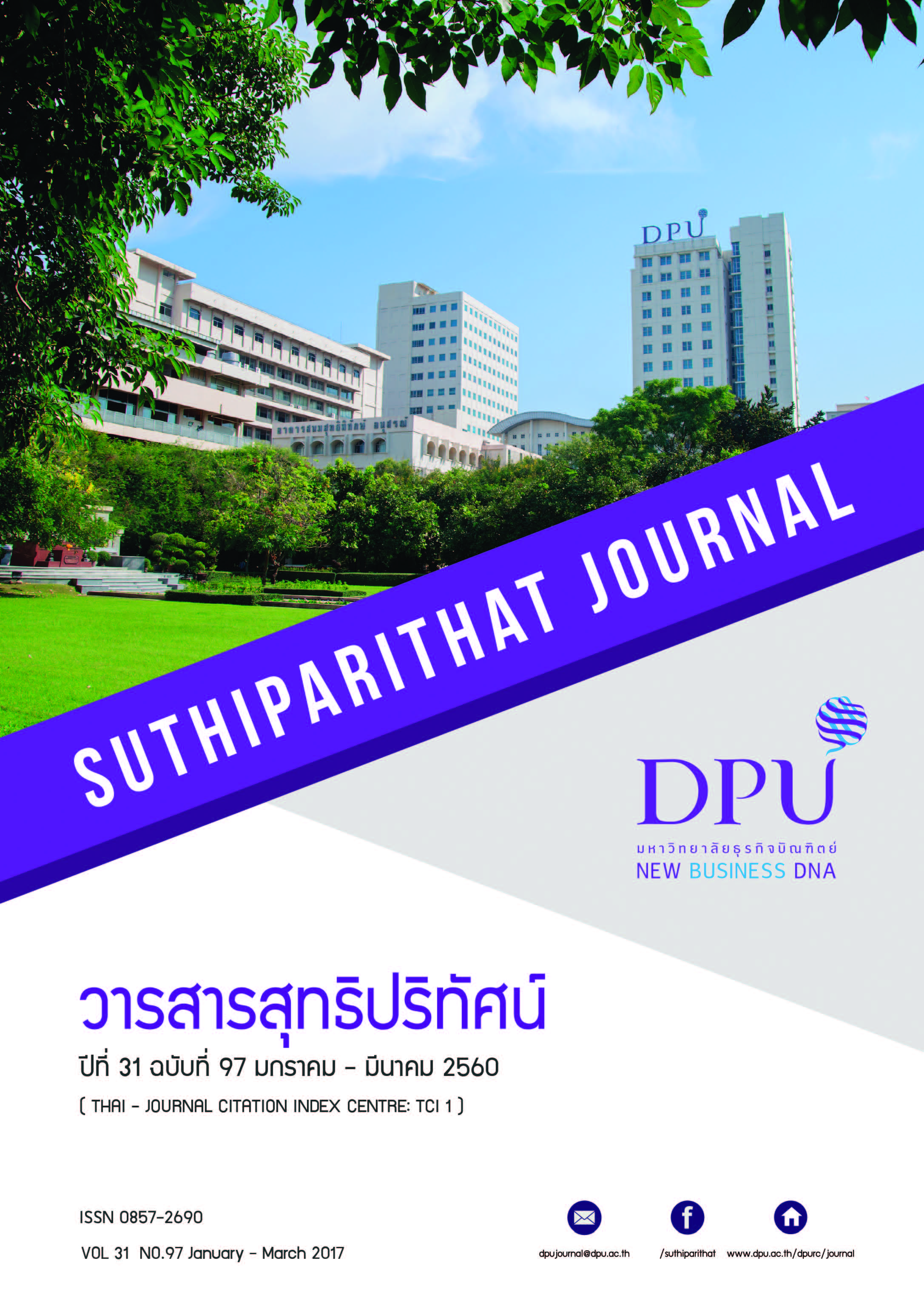ปัจจัยที่มีอิทธิพลต่อความสำเร็จของกองทุนประเภททริกเกอร์
คำสำคัญ:
กองทุนประเภททริกเกอร์, สมการถดถอยโลจิสติก, ปัจจัยเศรษฐกิจมหภาคบทคัดย่อ
ในช่วงที่ผ่านมากองทุนประเภททริกเกอร์ได้รับความนิยมเพิ่มขึ้นเป็นอย่างมาก การศึกษานี้ มีวัตถุประสงค์เพื่อศึกษาปัจจัยที่มีอิทธิพลต่อความสำเร็จของกองทุนประเภททริกเกอร์ในประเทศไทย ในระยะเวลา 16 มีนาคม 2547 ถึง 9 มิถุนายน 2559 โดยตัวแปรที่ใช้ในการศึกษาประกอบด้วย ขนาดของ กองทุน ณ วันเปิดกอง ดัชนีตลาดหลักทรัพย์ ดัชนีผู้บริโภค ดัชนีผลผลิตภาคอุตสาหกรรม และอัตรา แลกเปลี่ยนดอลลาร์สหรัฐฯ ต่อบาท การศึกษานี้ใช้การวิเคราะห์สมการถดถอยโลจิสติกแบบไบนารี่ ผลการศึกษาพบว่า ปัจจัยที่มีอิทธิพลต่อความสำเร็จของกองทุนประเภททริกเกอร์ประกอบด้วย ดัชนี ตลาดหลักทรัพย์ ดัชนีตลาดหลักทรัพย์กำลังสอง ดัชนีผู้บริโภค ส่วนข้อมูลปัจจัยอื่นๆนั้นไม่มีอิทธิพลต่อ ความสำเร็จของกองทุนประเภททริกเกอร์
เอกสารอ้างอิง
วศินี ตั้งทองหยก. (2553). ความสัมพันธ์ระหว่างเศรษฐกิจมหภาค อัตราผลตอบแทนทองคำและอัตราผลตอบแทนหลักทรัพย์ในตลาดทุน. (การค้นคว้าอิสระปริญญามหาบัณฑิต).กรุงเทพฯ: มหาวิทยาลัยธรรมศาสตร์.
นฤมล เฮี๊ยะศิริ. (2557). ผลการดำเนินงานกองทุนรวมทริกเกอร์ฟันด์ในประเทศไทยและความสามารถในการบริหารจัดการของผู้จัดการกองทุน (การค้นคว้าอิสระปริญญามหาบัณฑิต). กรุงเทพฯ: มหาวิทยาลัยธรรมศาสตร์.
ตลาดหลักทรัพย์แห่งประเทศไทย. (2558). กองทุนรวมคืออะไร. ห้องเรียนนักลงทุน. สืบค้น 18 กุมภาพันธ์ 2560, จาก https://www.set.or.th/education/th/begin/mutualfund_content01.pdf
Abbasi, M., Kalantari, E., & Abbasi, H. (2012). Effect of fund size on the performance of mutual funds evidence from Iran. Journal of Basic and Applied Scientific Research, 2(7), 6889-6902.
Chen, J., Hong, H., Huang, M., & Kubik, J. (2004). Does fund size erode mutual fund performance? The role of liquidity and organization. American Economic Review, 94(5), 1276-1302.
Chen, N., Roll, R., & Ross, S. (1986). Economic forces and the stock market. Journal of Business, 59(3), 383-403.
Flannery, M., & Protopappadakis, A. (2002). Macroeconomics factors do influence aggregate stock returns. The Review of Financial Studies, 15(3), 751-782.
Glosten, L., & Harris, L. (1988). Estimating the components of the bid-ask spread. Journal of . Financial International Journal of Business and Management, 11(6), 123-142.
Gorman, L. (1991). A study of the relationship between mutual fund return and asset size, 1974-1987. Akron Business and Economic Review, 22(4), 53-61.
Grinblatt, M. & Titman, S. (1994). A study of monthly mutual fund returns and performance evaluation techniques. Journal of Financial and Quantitative Analysis. 29(3), 419-444.
Haslem, J., Baker, H., & Smith, D. (2008). Performance and characteristics of actively managed retail mutual funds with diverse expense ratios. Financial Services Review, 17(1), 49-68.
Lindeen, E., & Gros, J. (2009). Does size affect performance? Study of size-driven effects on performance in Swedish equity mutual funds (Master Thesis). Stockholm: Stockholm School of Economics.
Mireku, K., Sarkodie, K., & Poku, K. (2013). Effect of macroeconomic factors on stock prices in Ghana: A vector error correction model approach. International Journal of Academic
Research in Accounting, Finance & Management. Science, 3(2), 32-43.
Nazir, S. & Nawaz, M. (2010). The determinants of mutual fund growth in Pakistan. International Research Journal of Finance and Economics, 54(1), 75-84.
Otten, R. & Bams, D. (2002). European mutual fund performance. European Financial Management, 8, 75-101.
Peterson, D., Petranico, A., Riepe, W. & Xu, F. (2001). Explaining the performance of domestic equity mutual funds. The Journal of Investing, 10(3), 81-91.
ดาวน์โหลด
เผยแพร่แล้ว
รูปแบบการอ้างอิง
ฉบับ
ประเภทบทความ
สัญญาอนุญาต
เนื้อหาและข้อมูลในบทความที่ลงตีพิมพ์ในวารสารสุทธิปริทัศน์ ถือเป็นข้อคิดเห็นและความรับผิดชอบของผู้เขียนบทความโดยตรงซึ่งกองบรรณาธิการวารสาร ไม่จำเป็นต้องเห็นด้วย หรือร่วมรับผิดชอบใด ๆ
บทความ ข้อมูล เนื้อหา รูปภาพ ฯลฯ ที่ได้รับการตีพิมพ์ในวารสารสุทธิปริทัศน์ ถือเป็นลิขสิทธิ์ของวารสารสุทธิปริทัศน์หากบุคคลหรือหน่วยงานใดต้องการนำทั้งหมดหรือส่วนหนึ่งส่วนใดไปเผยแพร่ต่อหรือเพื่อกระทำการใด ๆ จะต้องได้รับอนุญาตเป็นลายลักษณ์อักษรจากวารสารสุทธิปริทัศน์ก่อนเท่านั้น







